Dear Artist,
The other night while hanging out at a party a friend reminded me of Walter de la Mare’s “Look thy last on all things lovely, every hour.” Together she and I relished the idea that regularized, fleeting time might be added to an intensified appreciation of our world. Today I’m reviewing a system for nailing down my seeing. I call it “Eyeku.” Off and on I’ve filled a few trip-books and ring-binders with cryptic haiku-like items. Sometimes I’ve used a chiming watch to prompt the opportunity. Here’s a few from my patio right now:
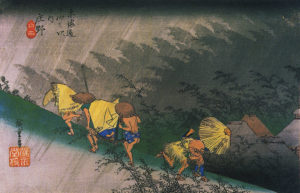
Travellers Surprised by Sudden Rain, 1833-34
From the Fifty-three Stages of the Tokaido
Colour woodblock
by Utagawa Hiroshige (1797-1858)
Creamy, dappled lichen on the gray trunk and branches of a flowering dogwood tree.
On high pilings, Purple Martin young, fluffed out, windswept, waiting to be fed.
By binoculars, two yellow kayaks with yellow-haired paddlers, girl and boy, heading out.
Airedale half in, half out of the sun, carefully licking up the last of my ravioli.
The potential of this system is to regularly exercise our powers of observation, to build on the joy of simple gifts. While it’s not possible to make a painting of everything within reach, nor would it be desirable, there is value in enhancing a wider life. By writing it down it becomes monumentalized and somehow more poignant. It gets you seeing potential in the little things, the mundane, the ordinary.
The early Japanese Haiku writers like Basho and Buson recognized the value of codifying simple observations. They adhered to a strict number of syllables in order to keep the form pure. “The octopuses in the jars, transient dreams, under the summer moon.” (Basho, 1644-1694) “Leaves, fallen on a rock, beneath the water.” (Joso, 1661-1704) “The cricket, climbs up the pot hanger, the night is cold.” (Buson, 1716-1784) My Eyeku are not so pure nor so poetically evocative, but they grab the eye-stuff and hold it. Any look at any thing could be a last look.
Best regards,
Robert
PS: “The faculty of creating is never given to us all by itself. It always goes hand in hand with the gift of observation.” (Igor Stravinsky)
Esoterica: What about sharing? Emailing four or five short and sweet Eyeku often result in surprising returns in kind. Give it a try. Copy your best to friends and see if they respond. You hardly need to explain what you’re up to but you can add “You can reply with yours if you wish.” Below are a few I’ve received, myself. I’m collecting them. They help us to realize that our universe is our constant and replenishing inheritance, and how diverse and great it all is.
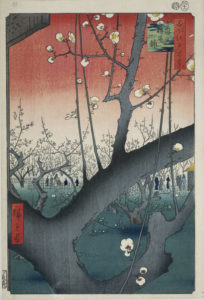
The Plum Garden in Kameido, 1853
From One Hundred Famous Views of Edo
Colour woodblock
by Utagawa Hiroshige
Eyeku
Purple cone-flower, softly a bee on yellow-speckled spikes, swaying in the breeze. (ab)
Young sparrow fluffed, momentarily left behind in gravel bath, camouflaged. (ab)
Headless white in shallows, bobbing heavy in swells, then stretching up long eyes to horizon. (ab)
A tiny bar, a lightning speedy robotic maniac bartender mixing apple martinis for 250. (sg)
At 3 a.m. we cross cobblestones and through a signless door, two chicks and a chaperone. (sg)
French toast and our respective cabs, we disturb the rats and climb our bedtime stairs. (sg)
A horizon glow, a prism up to the sky’s green center, shooting stars cutting. (js)
Green lace overhead, trembling, somewhere a big frog speaks. (lv)
A long dock, the sound of water, a cloud of flies hovering, one mad dragonfly. (lv)
(RG note) You are invited to share your own “eyeku” in the comments, below. Thank-you for your friendship.
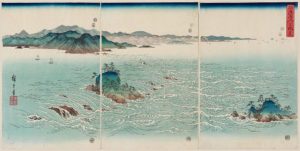
View of the Whirlpools at Awa triptych, 1857, part of the series Snow, Moon and Flowers
Colour woodblock
by Utagawa Hiroshige
This letter was originally published as “A last look” on August 17, 2004.
It is with my sincerest gratitude that I thank each and every one of you for your words of condolence for the loss of my Mother, Carol Noriko Genn. My family is humbled and deeply comforted by your kindness. With gratitude and friendship, Sara.
“There is nothing you can see that is not a flower; there is nothing you can think that is not the moon.” (Matsuo Basho)
Featured Workshop
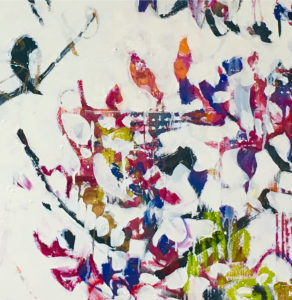 Join Ellie Harold for “Intuitive Painting: Permission to Paint Expressively,” designed especially for mature women artists of all skill levels who wish to explore this medium for soulful exploration. The retreat provides attractive accommodations (your own room!) along with lightly structured activities for centering, relaxation and low stress art-making. You’ll have plenty of free time to muse, paint, write and reflect while enjoying the colors, textures and flavors of San Miguel. This Retreat has the potential to transform not only your art but your life! You’ll return home with a specific art “care plan” to assure support for further creating. Details at www.EllieHarold.com.
Join Ellie Harold for “Intuitive Painting: Permission to Paint Expressively,” designed especially for mature women artists of all skill levels who wish to explore this medium for soulful exploration. The retreat provides attractive accommodations (your own room!) along with lightly structured activities for centering, relaxation and low stress art-making. You’ll have plenty of free time to muse, paint, write and reflect while enjoying the colors, textures and flavors of San Miguel. This Retreat has the potential to transform not only your art but your life! You’ll return home with a specific art “care plan” to assure support for further creating. Details at www.EllieHarold.com.
Featured Artist
Los Angeles-based artist Lisa Chakrabarti works in a variety of media: oils, acrylics, pastels, watercolors, graphite and colored pencils. Focusing on a style she calls “romantic naturalism” – impressionism based largely on subjects in the natural world – her works have found their way into galleries in Los Angeles, Florida, Colorado and New York. In 1995, after being introduced to sumi-e and Chinese ink painting by Asian friends, Lisa became captivated by the apparent freedom and subtlety of this ancient medium. This shift in focus has informed her work ever since.

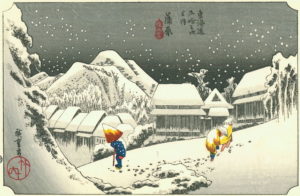
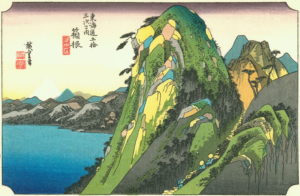
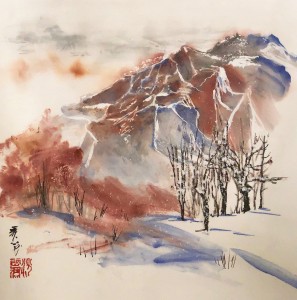



37 Comments
Midnight – a brand new skyscraper, blinking awake in light, where yesterday there was only night.
As a writer, I love this idea. I would enhance it (and my usual neglect of the other senses) by adding “Earku’s” and “Noseku’s” and “feelku’s”. Seems like it would provide rich reading/recall as I craft.
love it
Dear Sara,
Please accept my deepest condolences on the passing of your beloved mother. As a longtime fan of your Dad’s beautiful letters, it was lovely to get a picture of the lady who was his mainstay & strength for so many years. Thanks for this beautiful biography.
Sincerely,
Marilyn White
ps for your eyes only
Tongue-kus? Or does that sound gross. Perhaps Taste-kus.
Five senses alert
But sometimes I need a nap
Time to process it
Just taught a haiku books class at the John C. Campbell Folk School. Students wrote haiku non-stop, and we put the best into simple book structures. Oh my. What a week.
Folk School welcomes us
Muffled, as we greet old friends
Grin behind the mask
Mountains fade in grays
Subtle steps from light to dark
Rain smudges them all.
But wait, there’s more. But not here.
yes!!
And yes, I’m so sorry to hear about your mother’s passing. I imagine that she played a huge role in both yours and your father’s lives. His letters, as well as your own, have been an inspiration to me. This letter about eyekus in particular sums up the whole of the life a a painter. Watch your world, and then record it somehow, not just for others, but for yourself as well. The Japanese prints expand the eyekus even more.
I greet your letters with joy each time one appears; it gives me something to think about as I work on my gloriously repetitive projects.
Note: the letter above has 3haiku in it, but the formatting of these comments didn’t allow for line spacing. Hope you can find them.
Sweet.
This is lovely, Sara. Your father’s haiku and the delicate Japanese woodblock prints and your father’s invitation and yours to be still and see and hear . . . this is a very sweet way to remember your mother.
Sparkling kitchen floor
Scent of clean
Bare foot delight
Wonderful!
I appreciate your efforts in keeping the spirit of your parents alive. This bit has jogged my memory to days when I wrote poetry. It is like several things clicked, a desire fulfilled. I think I can write again and I know what will accompany my sketches. Blessings.
Squirrel scampering
In the bright scattered sunlight
On the wooden deck
Red sun signals smoke
Eyes turn anxiously to skies
Evacuate now?
Black profile pen in hand, clockface turning moment by moment
Such a wonderful post!! I used to get Painters Keys on a regular basis and just realized that I don’t receive them anymore…….and I miss them!!!
Could I please be on your list again?
So sad to hear of your mother’s passing. You are keeping your parents’ memories alive through these wonderful posts. Thank you.
Hi Merrilyn,
You can subscribe by clicking on the subscribe button at the top of this page.
Let me know how you make out.
Warmest Regards,
Sara
Numb when MotherLeaves
So much beauty left behind,
Her grace and full Heart.
What was
What will be
What is and what we do now
Lyn Asselta wrote of “seeing” recently. She is also anchoring in the moment to give time to “see.” I think these moments are nudging us out of the dark feelings we currently experience. Thank you for this eyeku idea.
I am sorry for you that your Mother passed but happy for her soul.
Thank you for an inspirational message!
Fiahing in the rain
Holding rod and umbrella
At the river’s edge.
Holy Spirit moves
Over the darkened water
Creator God speaks
barn swallows swinging sedately on high
Tiny seedlings sprout,
Between the rocks I placed there,
Signs of strength and hope
Eventually paint
Constantly nourish the soul
With nurturing light
swing ax
pings of kindling
split from sweet cedar shake
Dear Sara,
My sincere condolences to you and your family on the passing of your Mum.
Your father a giant, your mother his right hand.
Their arms are around you and your brother now.
❤️ From Diana
Ladysmith, B,C,
You so beautifully honour your mother. It helps me to think of how to be in the world from both sides. Thank you.
As koi ripple
the moon’s reflection
A tiny Buddha waits
Love your haiku, Joseph.
Dark summer cherries
Bursting with flavor
Fill my mouth with pleasure
Dark slates, rain wet and raven rhyming, this post, excellent timing. Gratitude.
x
Late afternoon sunlight
bathes dark rain-filled skies
On the edge – a rainbow!
I am truly sorry about the loss of your beautiful mother. (I lost my own in April and was shaken to my core, despite her advanced age and ample warning.)
No eyekus to share at the moment, but I’ll work on it! Wonderful idea. Thank you.
Torrents of rain slash against our window screen, but vaporize into cool mist on our faces as we watch from inside.
To zero in on one component and record a description – what a great way to overcome painter’s block. Imagine the fun and inspiration if done in a group!
Sara, sorry for your troubles
This is one of the best ideas I’ve seen or heard in forever. Thank you for doing what you do. Such a great inspirer.
Palms swaying summer breeze carries sorrow toward the sky